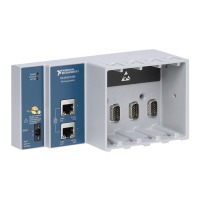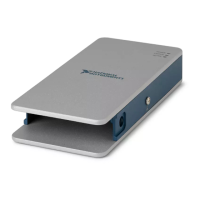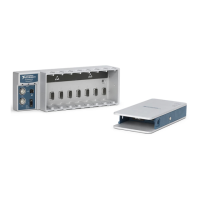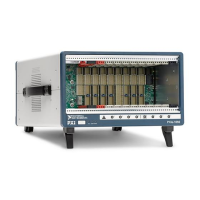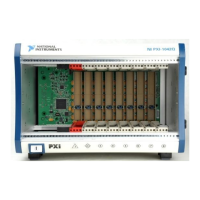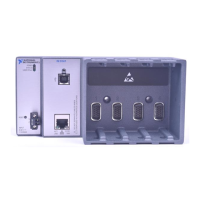© National Instruments | 4-7
cDAQ-9185/9189 User Manual
Using an Analog Source
Some C Series modules can generate a trigger based on an analog signal. In NI-DAQmx, this is
called the Analog Comparison Event, depending on the trigger properties.
When you use an analog trigger source, the samples are paused when the Analog Comparison
Event signal is at a high or low level, depending on the trigger properties. The analog trigger
circuit must be configured by a simultaneously running analog input task.
Note Depending on the C Series module capabilities, you may need two modules
to utilize analog triggering.
Analog Output Sync Pulse
You can use time as a trigger for sync pulses on delta-sigma C Series modules. To use a sync
pulse with a time source, specify a specific time in NI-DAQmx. Refer to the Time Triggering
topic in the NI-DAQmx Help for more information on accessing time-based features in the
NI-DAQmx API.
Note To accurately synchronize delta-sigma devices in two or more separate tasks,
you must specify the same sync pulse. Otherwise, a sync pulse is initiated by software
implicitly, even if time start triggers are specified for the tasks. However, for
multichassis tasks, the sync pulses and start triggers are automatically synchronized.
Minimizing Glitches on the Output Signal
When you use a DAC to generate a waveform, you may observe glitches on the output signal.
These glitches are normal; when a DAC switches from one voltage to another, it produces
glitches due to released charges. The largest glitches occur when the most significant bit of the
DAC code changes. You can build a lowpass deglitching filter to remove some of these glitches,
depending on the frequency and nature of the output signal. Go to
ni.com/support for more
information about minimizing glitches.
Artisan Technology Group - Quality Instrumentation ... Guaranteed | (888) 88-SOURCE | www.artisantg.com
